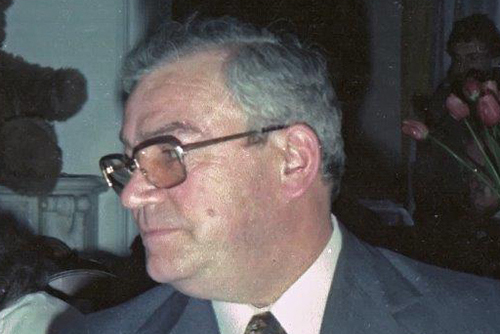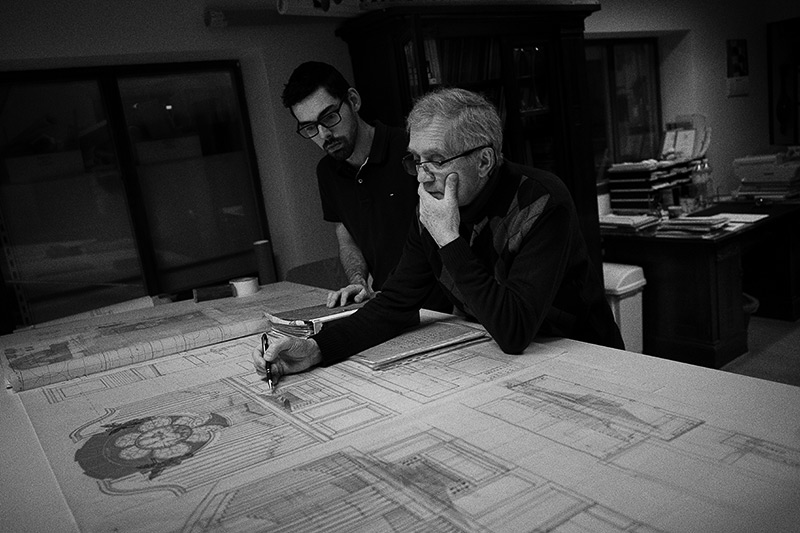History
The founder: Jean-Georges Koenig (1920-1992)

Jean-Georges Koenig is born on May 16, 1920 in Strasbourg. Raised in a music-loving family, he has felt very young his vocation for instrument making.
He joined the Roethinger family’s workshop, at the time when it was building the great organ of Strasbourg Cathedral. This organ is one of the first mechanical instruments built in Alsace during the 20th century.
There he would mingle himself with other factors, such as Alfred Kern, Ernest Muhleisen or Jean-Jacques Salmon, as known as “the mechanic”, coming from Mutin-Cavaillé-Coll. This has forged his taste for tracker action.
After twelve years of fellowship with the Roethingers, Jean-Georges was aspiring to spread his own wings.
In November 1945, he took over the business of the late Henri Vondrasek in Sarre-Union from his widow. As soon as he began, Jean-Georges strived to introduce some tracker action in his instruments, such as the ones of Petit Ebersviller or St. Antoine’s Church in Phalsbourg, in 1953. However, due to the competitive position of Haerpfer-Ermann, Jean-Georges was compelled to build mainly direct electric action organs, a much more attractive system for many organists at that time.
Around 1965, thanks to the impulse of Michel Chapuis, a young teacher appointed at the Strasbourg music conservatoire, Jean-Georges finally had the opportunity to focus again at tracker organs. Soon after, Koenig built the instruments in Léning, Brouderdorf and specifically the organ of Saint-Georges’ Church in Sarre-Union. Built in 1967, fitted in a case by Delorme dating from 1717, that instrument became a global reference, which made the Koenig manufacture well-known far beyond Alsace-Lorraine. This instrument was actually the first organ built after the precepts found in Dom Bédos’ treatise of 1766. Reviews were unanimous and this international recognition opened new horizons to the small family business.
The second generation: Yves Koenig (1950-…)

In this exhilarating atmosphere of rediscovery, Yves, Jean-Georges’ son born in Sarre-Union on 16 May 1950, stepped into the family business in 1968, after having studied mechanics. Father and son have been working together between 1968 and 1983.
This period is especially marked by the restoration of the organ of Lorris in 1974. This restoration was characterized by a genuine concern for understanding the ancient construction techniques and the will to fully preserve the old materials. At that time, the thinking about organ restoration conduct and ethics were at a very early stage. It was very unusual to choose to round out, consolidate and refill existing pipes, instead of replacing them by copies. This respect for original materials and techniques has helped Koenig to push the reconstitution very far, using the same wood species and cuts, the same alloys for metal pipes, and the same joinery techniques, as used for the original elements.
After the reconstruction of the organ in Sarre-Union, the manufacture has almost exclusively built organ with suspended tracker action, whose qualities have become a reference in the trade. Despite an apparent specialization for the range of French classical organ, as soon as 1972, Koenig turned its interest towards the organs of the Netherlands, and those of Central Germany and South Germany. The completion of the organ for the Vrije Universiteit in Amsterdam was the first contact with the Northern European organs. This quest went on with the study of several organs in the spirit of John-Sebastian Bach, in Saxony and Thuringia, and it inspired the creation of the instruments of St. Guillaume’s Church in Strasbourg, Orsay, Soleuvre, and more recently, St. Joseph’s Church in Macau.
In 1983, Jean-Georges Koenig handed over the lead of the manufacture to his son Yves, allowing him to make known and export the French classic pipe-organ. During the 1980s, the Koenig workshop has been living in a kind of golden age for classic French organ restoration. At that time indeed, the organs of Rodez, Mende, Valence, or Joinville were restored by Koenig. Those restorations were willingly respectful of the ancient materials, in line with what had been done in Lorris. The decade also saw the construction of new organs, still in the classic French style, as in Pierrefonds, La-Roche-sur-Yon and Saint-Malo. In order to get out of the tide of “minimalist” casework, Yves embarked on researching ornamentation. For these new organs, he could design cases fitting better with the musical aesthetics.
The 1990s decade was marked by a more pronounced orientation towards German aesthetics, as shown in the organs of Saint-Dié, Sarreguemines or Charleville. However, the workshop also realized organs with a somewhat hybrid aesthetics: « Saxon in their flesh but Parisian in their genes », like in Osaka or Regensburg.
The early 2000s are characterized by a large variety of projects, which are more difficult to link to a specific trend. Yves Koenig built then several new organs, wishing to offer at each time the best sound and aesthetic possible integration in the local project.
The Koenig-Marchal collaboration (2008-…)

In 2008, Julien Marchal, born October 29, 1990, entered in apprenticeship in the workshop after a literary high school degree. Organ enthusiast from his early age, tenured organist of Hesse abbey church – where sits an organ restored by Jean-Georges and Yves Koenig – he has subsequently passed a joinery vocational certificate and a professional degree. Since joining the company, he has had the opportunity to gradually expand his field of skills, from joinery design to harmony, in order to be able to eventually succeed to Yves Koenig at the head of the manufacture.
In the recent years, restorations took a growing share in the trade of Koenig. The workshop, however, was keen on continuously improving its conduct. Julien Marchal’s arrival allowed the start of an association with the world of museum curation, thanks to his participation in the wood group of the French Section of the International Institute of Conservation. This allows the team to be regularly informed of the research conducted by the scholars of Inp, C2RMF or LRMH, in such fields as restoration materials, control of wood-boring insect and micro-organic pests, or historical varnishes.
During the 2010s, several new organs are born so far: one in Macao, with a German aesthetics, another one in Luz-Saint-Sauveur, inspired by instruments from Northern Germany, and the new chancel organ of Saint-Malo Cathedral. This last one differentiates itself by a design which skilfully combines tradition and modernity. Its oak wood case, designed in the French 18th century style, houses a carbon fibre key action transmission. A fixed and mechanical reversed console works alongside with a second movable and electric one, thus allowing the instrument to better mix with any musical ensemble. Other organs were built in Germany (Speyer BKI) and Austria (Kapuzinerkirche in Vienna). Some new organs are already to come abroad, demonstrating the continuing extension of Koenig’s sphere of influence, far beyond Alsace-Moselle where it originated.
